The Internetdominates information today. We can check https://earth.google.com/web/ and see actual cannabis gardens with big plants in northern California. Amazing views of legal cannabis gardens! Security issues have changed immensely during the last few years in the United States and countries that allow or tolerate medical cultivation of the cannabis plant. As legal patients and cannabis gardeners, we do not have to worry about losing our homes in the USA to “double jeopardy” laws that prosecute gardeners as criminals, and later in civil court where we are subject to asset forfeiture laws and unsavory “criminal” vultures extorting “favors” while we cower in the shadows. We can talk freely with fellow gardeners, patients, and caregivers without fear of being labeled as so-called mafia or organized crime and subject to RICO* and other prejudicial laws. The Internet gives cannabis cultivators—medical and recreational alike—the ability to gather information yet remain anonymous in this worldwide legal turmoil. Digital cameras and camcorders allow us to share our gardens with fellow gardeners with little or no fear of being discovered. The flood of Internet information is overwhelming to prohibitionists that criminalize sick people and work counter to the laws of Mother Nature and the cannabis plant.
*Racketeer Influenced and Corrupt Organizations [Act] (RICO) USA.
Many politicians, law-enforcement agents, and ill-informed people continue to wage war on the cannabis plant, US citizens, and citizens of many countries. They have an impressive arsenal, including draconian laws, misinformation, and high-tech surveillance gizmos. The USA Patriot Act and the Homeland Security Act of 2002 further erode personal rights of individuals. Unfortunately, the US government has done its best to export this paranoia.
“Legal” medical cannabis gardeners are obligated by local law to keep their paperwork in order. At press time there are 18 states and the District of Colombia (19 total) in the USA with medical cannabis laws.* Around the world, laws vary immensely between countries, zones, states, provinces, and cantons. And the laws in many areas are unclear and often change from jurisdiction to jurisdiction. Cultivating cannabis for any reason is illegal under US Federal Law Statutes, and the international “Single Convention on Narcotic Drugs of 1961.”** However, even the Federal Government has designated medicinal cannabis legal in a handful of cases. Confused? So is everybody else— including law enforcement and politicians. Consequently, medicinal cannabis laws are open to interpretation. Check the NORML (National Organization on the Reform of Marijuana Laws) website, www.norml.org, for updated laws and requirements for medical cannabis patient cardholders in the USA. Study news from other countries to learn how their cannabis laws are changing. For the first time in recent history, cannabis antiprohibitionists are on equal ground with prohibitionists in the world.
*Alaska, Arizona, California, Colorado, Connecticut, Delaware, Hawaii, Maine, Massachusetts, Michigan, Montana, Nevada, New Jersey, New Mexico, Oregon, Rhode Island, Vermont, Washington state, and Washington, DC.
**http://en.wikipedia.org/wiki/Single_ Convention_on_Narcotic_Drugs

Even though medicinal cannabis is legal in many states in the USA, countless US citizens are arrested every year. Please pay attention to local laws!

The Marijuana Policy Project (MPP) is behind many state cannabis initiatives. The MPP lobbies Congress to reduce Drug War budgets and stop deceptive anti-cannabis campaigns.

Headed by Ethan Nadelmann, the Drug Policy Alliance (www.drugpolicy.org) is an excellent website to look for current Drug War facts and political action to stop the crazy war.
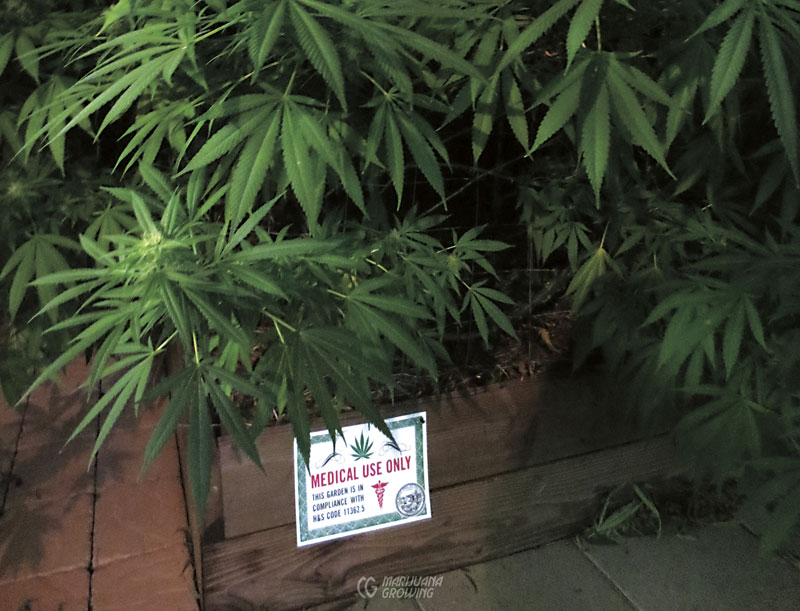
Posting a “Medical Use Only” notice that states the garden complies with state law can be used as “evidence” should problems arise.
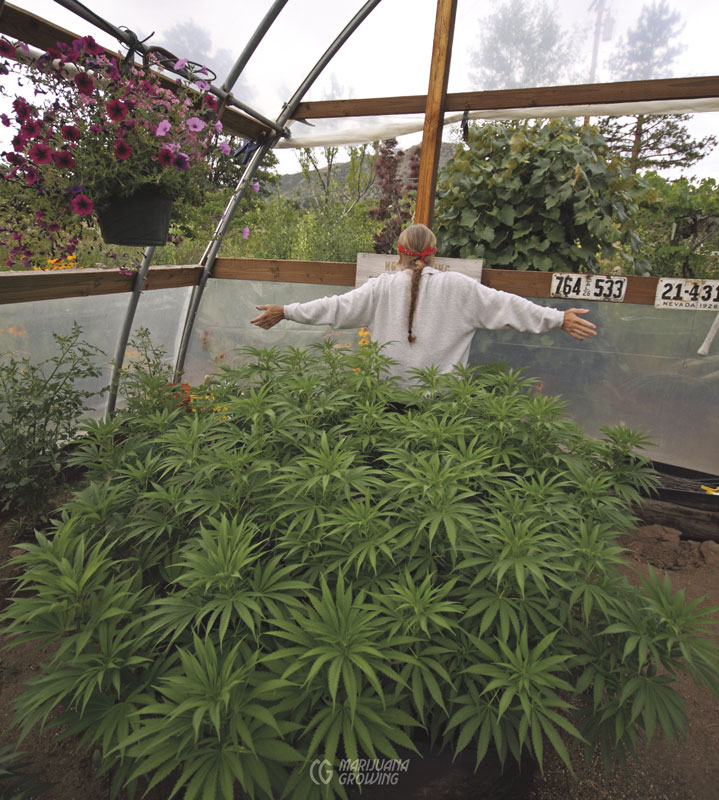
Outdoor and greenhouse gardeners are subject to climate change and Mother Nature’s needs. Some years are better than others. For example, in 2011 the outdoor harvest in California was lighter overall than in 2010 because of a cold, wet spring and early autumn rains. Insightful gardeners planted more plants overall to make up for difficult growing conditions.
Even though the sunlight afforded by complete legalization can be seen among the clouds, medical cannabis gardeners in “medical” and “nonmedical” cannabis states must still be concerned with security. The retail market value of medicinal cannabis is about $15 USD per gram and $15,000 USD per kilo (2.2 pounds) at medical dispensaries. Gourmet tomatoes, a comparable legal crop, fetch up to $10 USD per pound (454 gm). On the black market a gardener can sell the crop for 10 to 50 percent or more. However, wholesale prices are much less than $15,000 USD/kg. For example, the retail price in the USA for one pound (454 gm) oscillates between $800 USD for low-quality outdoor cannabis and high-quality indoor/greenhouse cannabis that fetches from $2,500 to $3,200 USD per pound (454 gm).
The inflated value of medicinal cannabis makes gardens an easy target for criminals and law enforcement. The monetary value of cannabis has made it a hostage of the black market. Secret medical cannabis gardens are just like the name says: secret. I asked members on my website, www.marijuanagrowing.com, about sanctuary preservation concerns. Secrecy and maintaining a normal lifestyle—paying bills and taxes, going to little league games, and so on—topped the list. Untold quiet medical cannabis gardeners have been harvesting crop after crop for decades in Drug War–torn America and many other countries around the world. Every year cannabis-related arrests increase but actually appear to promote a disproportionate increase in cannabis cultivation. Supply increases, demand increases, and market prices drop. It is simple economics. See www.norml.org for more information.
Security—personal, family, home, and sanctuary—comes first. Thieves, both illegal and legal, can do you, your family, friends—human and animal—physical harm or worse. Thieves and government officials violate private homes and garden sanctuaries with little or no threat of legal recourse from you. In many countries, states, and provinces, law enforcement can detain you, your friends, and your family—they can even kill your pets!— all under the cloak of law.
Indoors, efficient medical cannabis gardeners in this Drug War–torn world should be able to harvest 0.4 to 0.5 grams of (dried) flower buds from heavy varieties (less for others) every month for each watt of light in the flowering room. Often, indoor medical cannabis gardeners harvest half (or less!) of the possible har- vest. A half harvest is inefficient and a misuse of assets. Even such “successful” harvests leave twice the carbon in the environment relative to harvest weight. Indoor gardeners who do not harvest this much may be inexperienced, working too hard, or lazy in regard to achievable results, and often cheating the environment. Master the basics of growing medical cannabis, and you will be rewarded with a more robust harvest. Remember, greenhouse and outdoor gardeners are subject to climate and space restrictions and should plant early and harvest often!
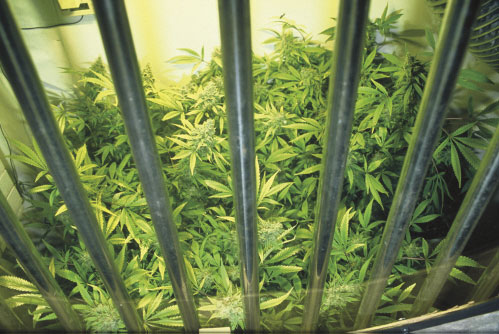
Unfortunately, medicinal cannabis has been kept behind bars for many years. During the last 15 years’ progress in California, Colorado, Washington state, and other medical cannabis states, this condition is changing.
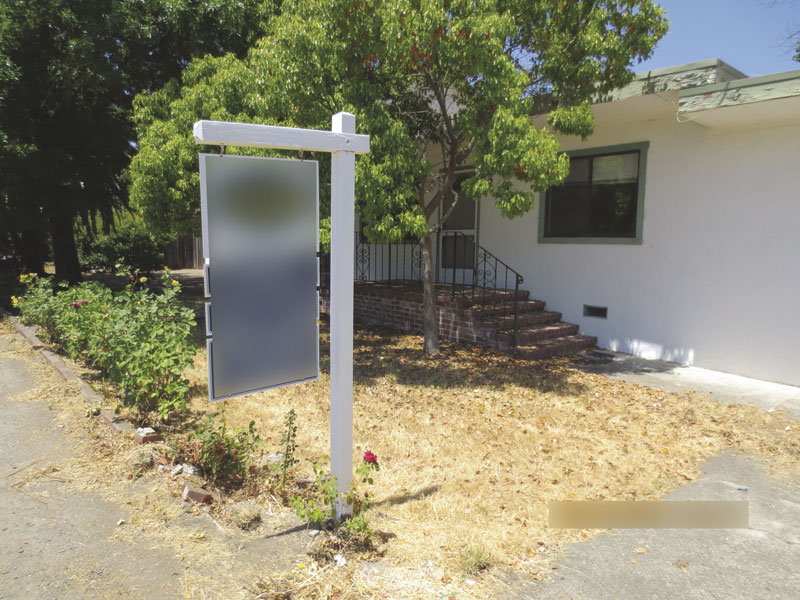
Medical cannabis gardeners in currently non-medical states in the USA often garden in rental houses.
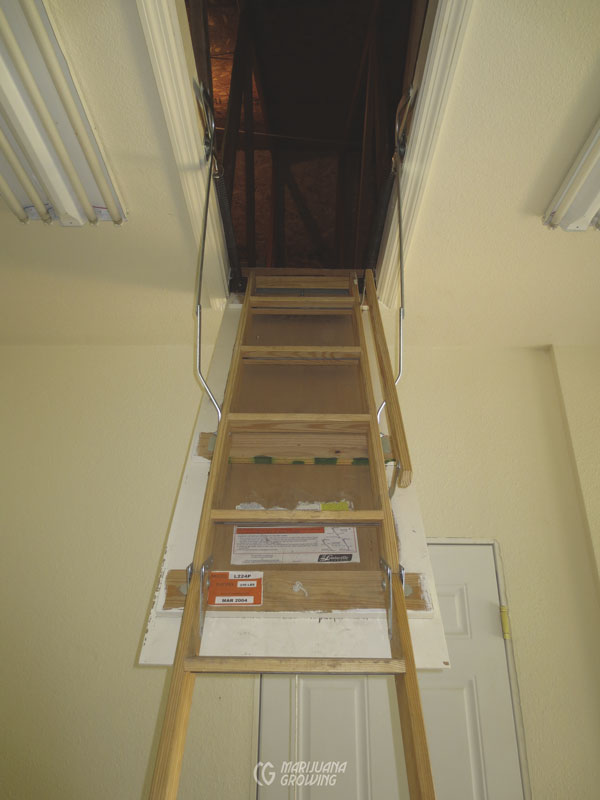
This medical cannabis garden in an attic is accessible via a pull-down stairway.
In the USA, individual medical cannabis gardeners who cultivate fewer than 99 total plants are seldom prosecuted under federal laws that require a 5-year minimum sentence with no parole when convicted of growing 100 to 1,000 plants.
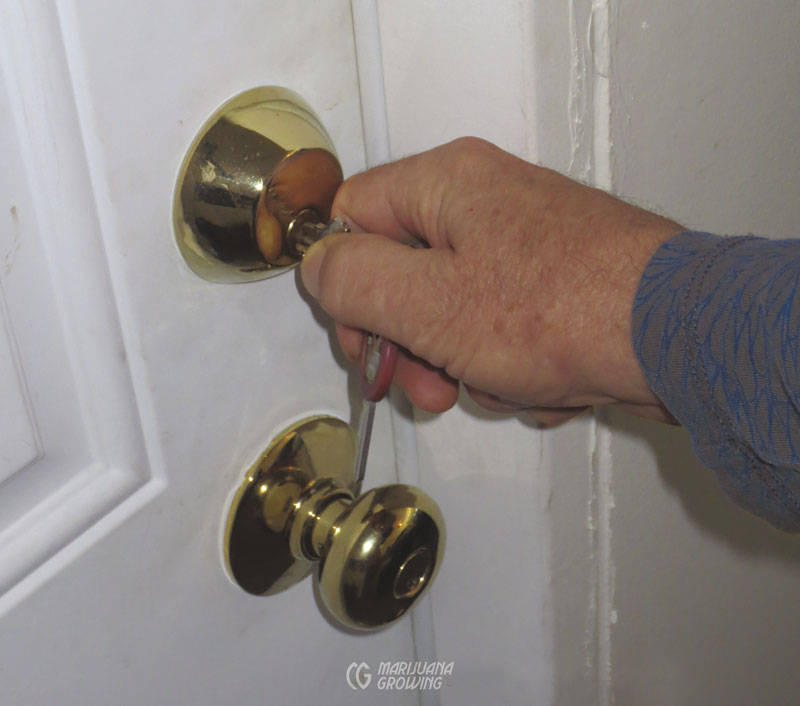
Keep the medical garden room locked to prevent unwanted visitors.

A simple search for “marijuana insurance” will net several bona fide insurance companies.
Sanctuary Preservation
The vast majority of medical cannabis gardeners are normal people with a regular schedule, simple lifestyle, and pleasant demeanor. They keep their gardens and grounds in line with neighborhood standards. They do not have noisy, wild parties, and they get along well with neighbors.
Showing a medical garden to anyone who has no direct involvement invites problems. People like to talk and embellish. Once the word gets out, your garden may be subject to compromise and theft. Strangers can also bring diseases and pests into the garden.
Even though medical cannabis may be legal where you live, neighbors, visitors, and family members may oppose it and create conflict. Indoor medical cannabis gardeners are able to attain peace of mind for themselves and loved ones by installing a secret entrance to gardens via false doors and difficult-to-find entrances through workshops, basements, and attics.
Some gardeners mount a tool pegboard or painting over the door to disguise the garden room’s entryway. The locked door is controlled with a remote electric door opener.
Insurance: If you are concerned about medical cannabis crop theft and equipment theft you can buy insurance and security services. Many companies sell home security systems. Search “home security systems” on the Internet to learn about current security issues and surveillance devices. Companies such as Medical Marijuana Insurance will insure your medical cannabis crop. This company insures medical cannabis gardeners, processors and dispensaries against economic loss to their crop from natural and unnatural hazards. Use your favorite search engine to check for other companies that insure valuable medical cannabis.
Sanctuary Preservation Precautions
- Purchase seeds and clones at local medical cannabis dispensaries.
- Do not have seeds or gardening products sent directly to your home or garden site. Have the merchandise sent to a “safe legal” address.
- Pay for mail order merchandise with a money order.
- Have a reasonable electric bill. Pay all bills and make all garden purchases with cash.
- Do not visit illegal cannabis gardens or real criminals who lie, cheat, and steal.
- Restrict access to your garden. Keep gardens under lock and key whenever possible.
- Make discovery of and entry to the garden difficult.
- Secure the perimeter around the garden house, greenhouse, or outdoor garden. A sturdy fence, motion-detecting floodlights, security cameras, and possibly a guard dog will help ensure security for the sanctuary.
- Unload grow supplies a little bit at a time or from within a locked garage.
- It is a bad idea to talk on the telephone about medical cannabis in states that do not sanction it.
Sanctuary Surveillance
Motion detectors are an inexpensive ($10–$200 USD) added level of security for most all medical cannabis gardeners. A central receiver can be used to collect signals from several different wireless sensors. Motion sensors are also built into garden and industrial security floodlights. The lamps turn on when a small sensor detects motion. Other motion detectors can be used to activate alarms, security cameras, and sprinklers via a solenoid valve. Indoor gardeners use motion-detector floodlights around the exterior of the garden area to intimidate and expose unwelcome guests. Outdoor gardeners use motion detectors and security cameras to activate lights and sprinklers to scare off destructive plant predators such as deer, rabbits, and thieves. Check www.homesecuritystore.com for burglar and fire alarms, security cameras, and motion detectors.
Predator trail cameras: Security cameras are affordable ($100+ USD) and easy to set up. With a security camera, you can monitor video and sound from your television or computer. Indoor gardeners set up cameras outside the building, usually trained on entry points such as doors and windows. Outdoor gardeners mount cameras to monitor activity in the garden. More expensive security camera systems can be remotely monitored via computer, iPhone, or Android telephone. Using your cell phone, you can literally watch your garden grow!
Inexpensive security cameras do not encrypt the video signal and can potentially be viewed by anyone with a similar camera that operates at the same GHz. Higher-quality models encrypt the signal and are much more secure. Medical cannabis insurance policies usually require garden-security video surveillance.
Outdoor gardeners can also use a garden camera ($80 USD) or, as deer hunters do, a trail camera ($100+ USD). Mount battery-operated weatherproof digital cameras in discreet locations in the garden and on trees along the trail. Some cameras are motion activated and others take photos at specific intervals. Download the digital images—stills or video clips—every week. Review the images to see if birds, deer, rabbits, thieves, or other perpetrators have been visiting your garden. Images have date and time codes to identify when the culprits appeared. Also use the cameras to take timed photos of your garden during the growing season. Compile all the photos sequentially to form a time-lapse video of the garden growing from beginning to end. Some cameras are equipped with a flash for nighttime photos. The flash also frightens and drives nocturnal deer and other animals away from the cannabis garden. Often, the flash is all the deer control needed. Check www.gandermountain.com, a hunting, fishing, and camping website that has a huge selection of predator trail cameras.
After having had his cannabis crop stolen, a gardener friend installed predator trail cameras around the garden and on the nearby trail. When suspected thieves found his garden again, the cameras snapped their pictures along with the date and time they visited. The gardener had plenty of time to move the plants to a safe spot. He also had photos of the thieves and was able to identify them.
Keep predator trail cameras in place all year to monitor hunters, potential thieves, and plant-predator animals. Find out where there is no human traffic, and grow there. Search YouTube for actual predator trail camera videos. Remember that others use trail cameras too! Trail cameras are inexpensive, and hunters often use them to find prey. Do not fall victim to these cameras. Self-portraits are not a good idea!
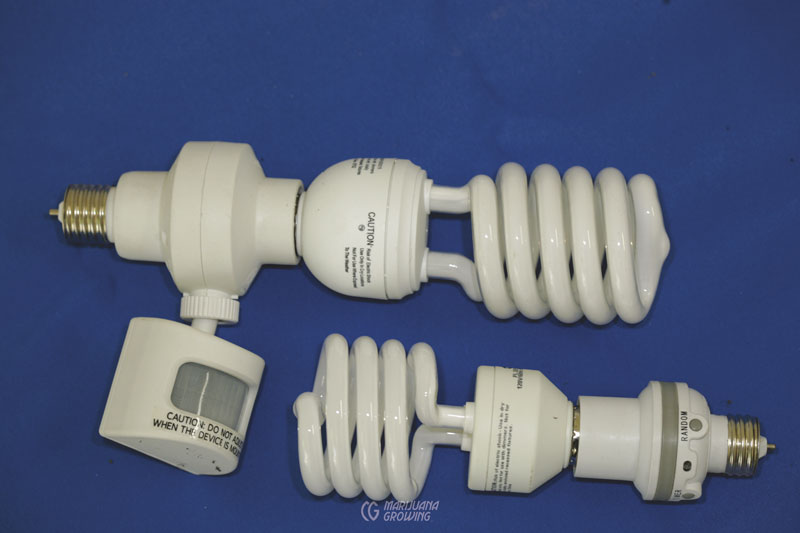
Inexpensive motion detectors are often attached to lightbulbs.
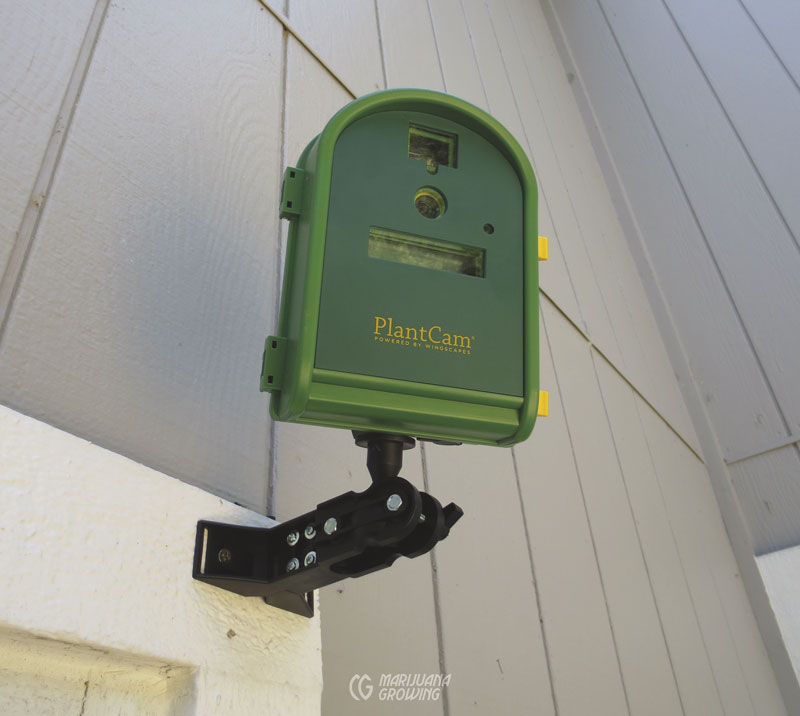
This PlantCam takes a photo every 5 minutes. It records the progress of the garden and any movement in the garden. Photos are recorded on a small camera chip.
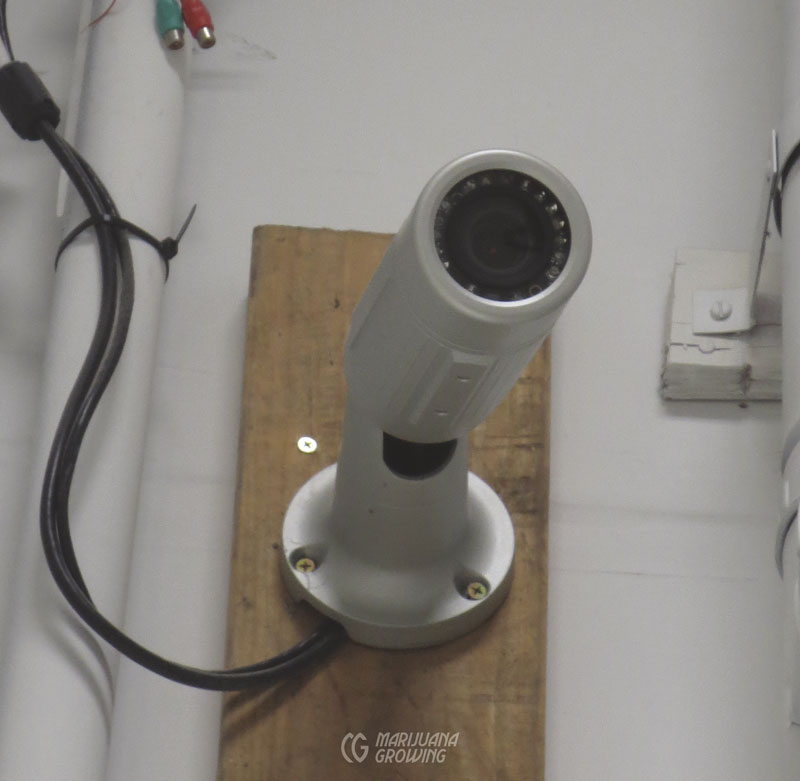
A closed-circuit security camera is simple to mount. All data can be fed directly to a computer, and it is easy to access the camera via an iPhone.
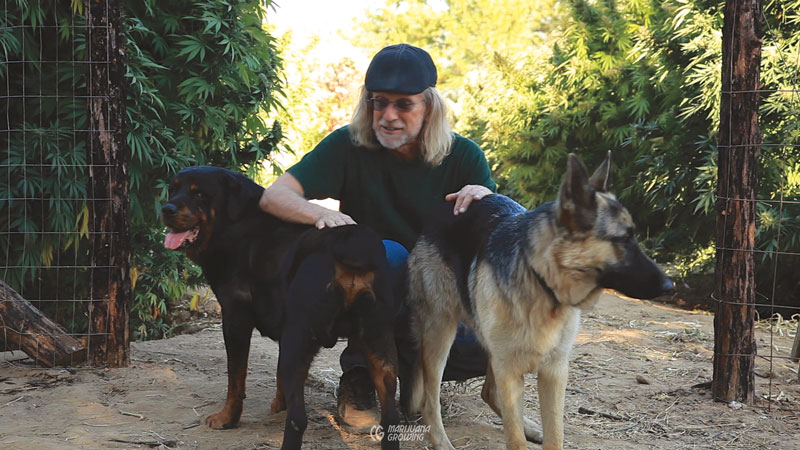
A convincing guard dog is one of the best deterrents against thieves.
Sound Security
Insulate garden structures with a mass barrier like brick, thick glass, concrete, or metal to prevent sound transmission. “Sound board” is popular in North America. Absorb sound with spongy or porous open-cell foams and spun fiberglass. Stop vibrations by dampening the energy and shunting it off into a pad made of foam, cork or carpet, with rubber or spring mounts.
When making a sound barrier, use construction adhesive instead of screws driven into the walls. Screws touching both interior and exterior walls transmit sound to the outside wall.
| SOUND TRANSMISSION CLASS (STC) RATING* | |
| Decibels | What You Can Hear |
| 25 | Normal speech is easy to understand. |
| 35 | Loud speech is audible but intelligible. |
| 45 | Loud speech sounds like a murmur. |
| 45 | A single layer of half-inch drywall is fixed to 6-inch (15.2 cm) lightweight concrete block wall. |
| 60 | Most sounds are inaudible. |
| 60 | A double layer of half-inch drywall covers wood on both sides of stud wall. The double wall is spaced 1 inch (2.5 cm) apart with batt insulation in between. |
*Sound Transmission Class (STC) Rating
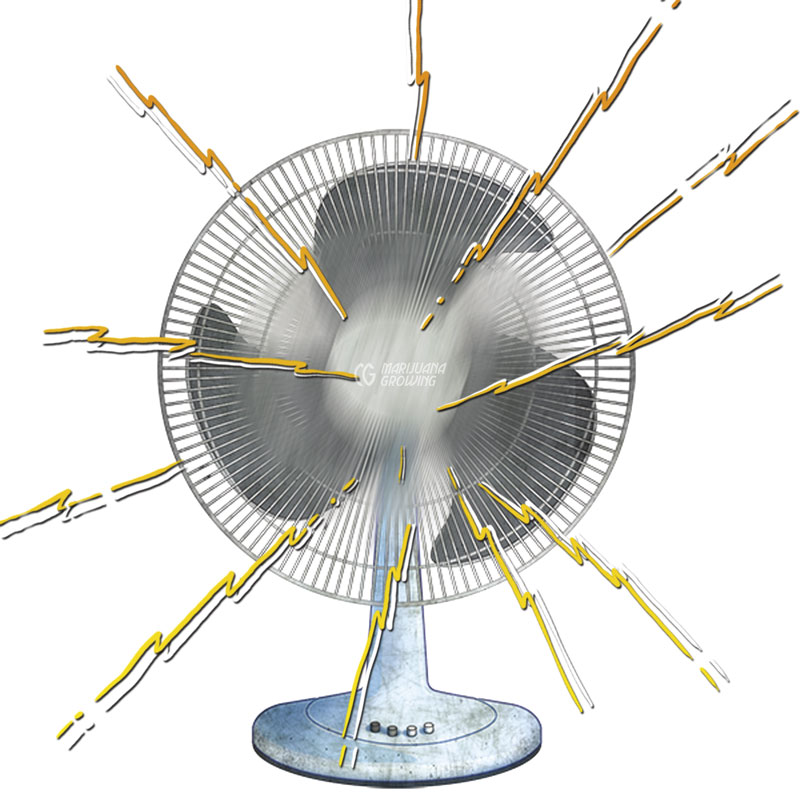
A squeaky fan is annoying and a telltale sign of a garden room.
Build a box or an extra room around analog ballasts to muffle noise. Remember to allow for airflow. Digital ballasts require minimal noise insulation, sometimes none at all. Place a thick pad under ballasts to absorb vibrations.
High-quality inline fans are much quieter and more efficient than squirrel-cage blowers. Install large inline fans and operate them at a low rpm to reduce noise levels.
Wrap ducting with insulation to baffle noise. Insulated ducting is also available. Fit duct outlets with a dryer hose wall outlet or something similar. The vent fan is then placed near the ceiling so it vents out hot, humid air.
Weight and thickness of a partition dictate its ability to block sound. Soundboard added to a wall drops about 5 decibels (dB) of sound. A 3-inch (7.6 cm) airspace will lower sound transmission by 6 dB. Walls insulated with dense or batt insulation cut sound well.
Use a decibel meter (see chapter 15, Meters) to measure the sound from your garden room.
Noise cancellation generators offer old technology to indoor gardeners. A microphone records the sound that is then analyzed by a computer. Sound waves with opposite polarity (180-degree phase at all frequencies) are generated and output through a speaker. This causes “destructive interference” and cancels most of the noise. Noise cancellation generators work best when sound can be contained in a small area such as ventilation ducting.
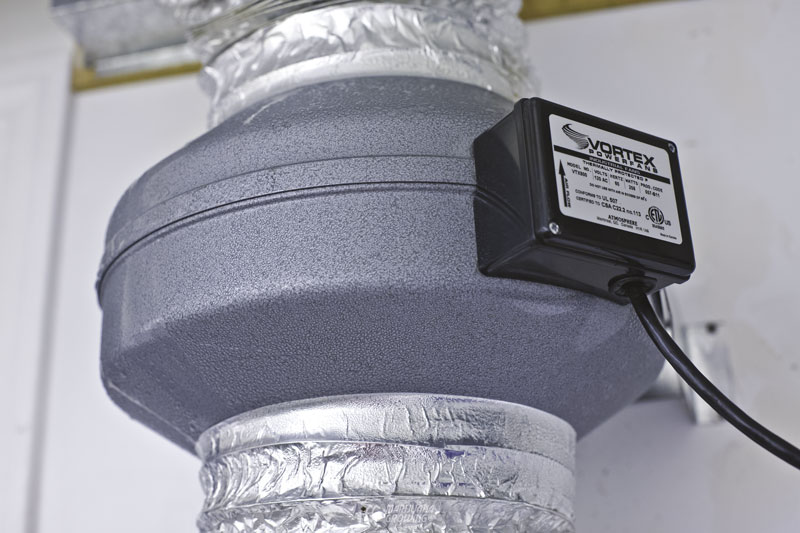
Inline fans run quietly. They efficiently move a lot of air out of the garden room.
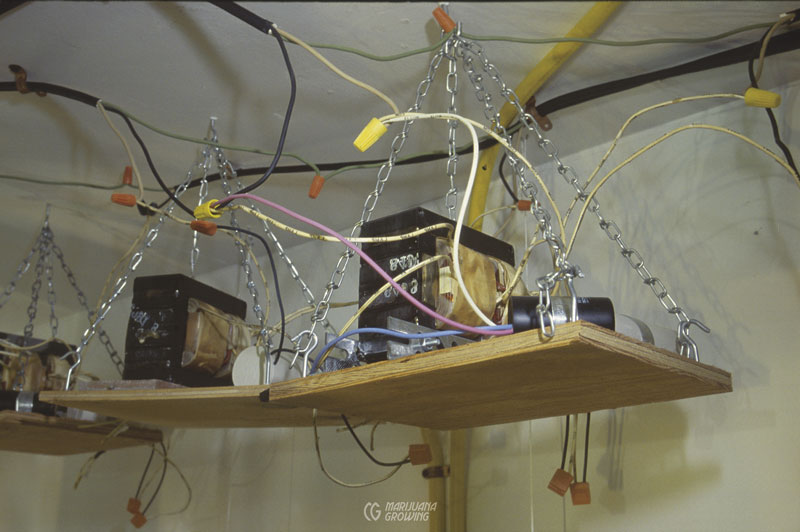
These exposed ballasts are not only a fire hazard, they vibrate and make a lot of noise.
Light Leaks
If light escapes from vents, give ducting a 90-degree turn and paint the inside of the ducting black where it turns to eliminate unsightly light leaks. Baffle light shining out chimneys and roof vents. Check for light and air leaks. Set up the fan and go outdoors after dark to inspect for light leaks so that neighbors are not concerned or annoyed.
Fragrance
To minimize ground-level fragrances, expel carbon filtered and ozone-treated air via a roof vent or chimney. Treat air with a deodorizer or filter that traps odors before evacuating them. See “Fragrance” in chapter 16, Air, for a complete rundown on deodorizers and air filters. To ensure safety, Check with a qualified professional when installing a ceiling vent or when venting a chimney. See “Setting Up the Vent Fan” in chapter 16, Air.
Do not let air-conditioner water expelled from sealed garden rooms drain outdoors; it smells like cannabis and could draw cannabis- or catnip-loving felines, drug-sniffing dogs, and other pests.
Surround garden property with a bed of fragrant cedar shavings or chips in the flowerbeds. Few flowers have such pungent odors during the fall, and we have no examples of fragrant flowers to thoroughly mask the fragrance of flowering cannabis.
Greenhouse fans are equipped with louvers (flaps or baffles) to prevent backdrafts. During cold and hot weather, undesirable backdrafts can alter the climate in the room and usher in pests and diseases. Installing a vent fan with louvers eliminates backdrafts but may present a security risk.
Law enforcement in some jurisdictions collects information via hearsay evidence—trash, surveillance records, and so forth—to obtain a “warrant” to search the premises of medical cannabis gardeners. If law enforcement discovers a cannabis garden, they can legally continue to build the case against the gardener by using anything the gardener says. They legally collect most of the information from the gardener, friends, and family. Do not be the weakest link in the chain.
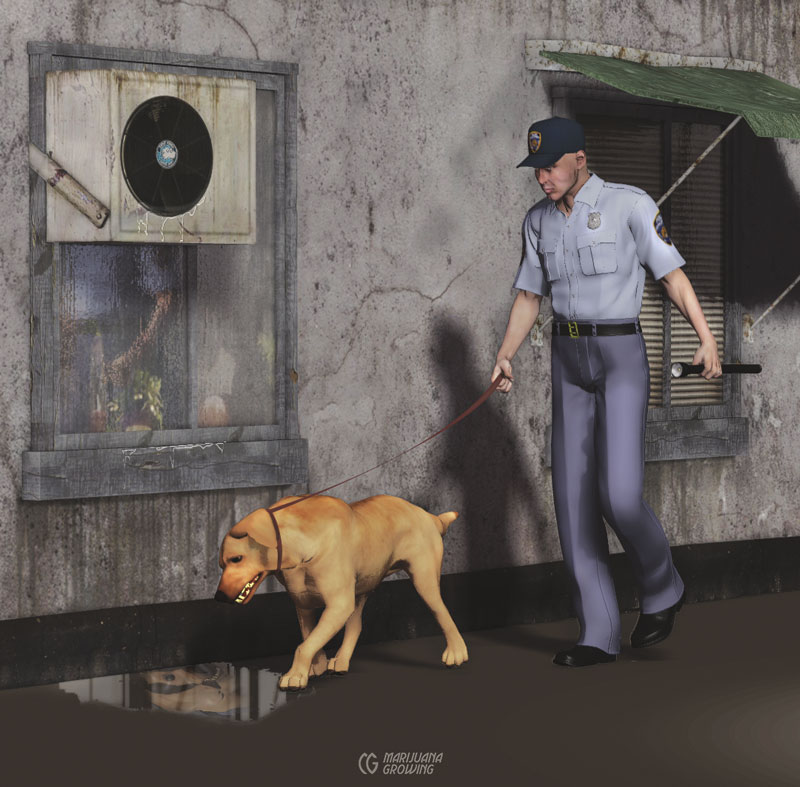
The fragrance of cannabis is concentrated in water expelled from an air conditioner. Always keep condensed water from the air conditioner inside the growing area.
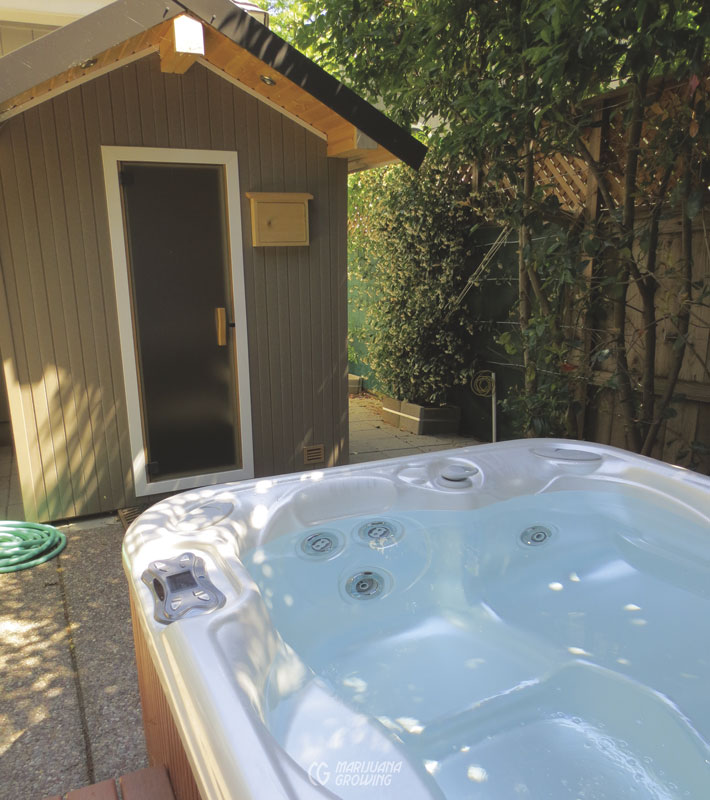
Turn off hot tubs and saunas to conserve electricity for use in the indoor medical cannabis garden.
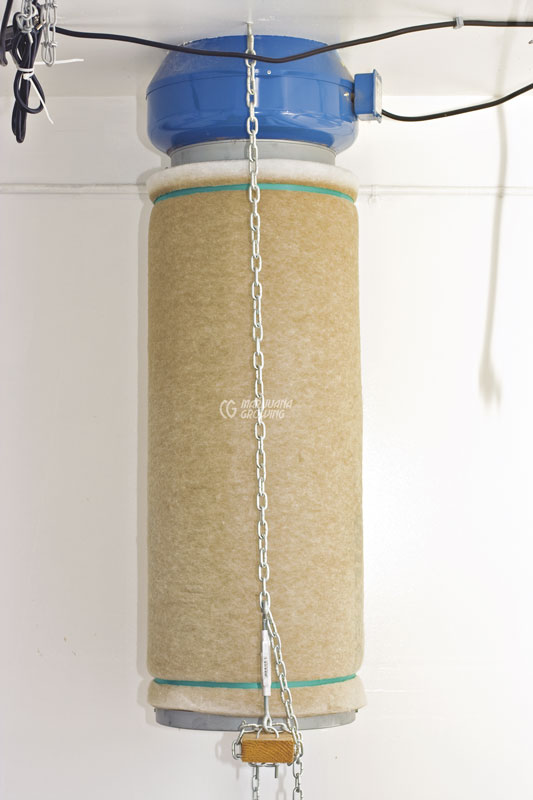
A carbon filter is essential equipment to remove unwanted fragrances in the air before evacuation.
Electrical Security
Keep electrical use to a reasonable amount for your home and neighborhood. And above all, do not steal electricity. See sections on “Electrical Safety,” “Electricity Consumption,” “Conserve Electricity,” and “Smart Meters” in chapter 17, Lights, Lamps & Electricity.
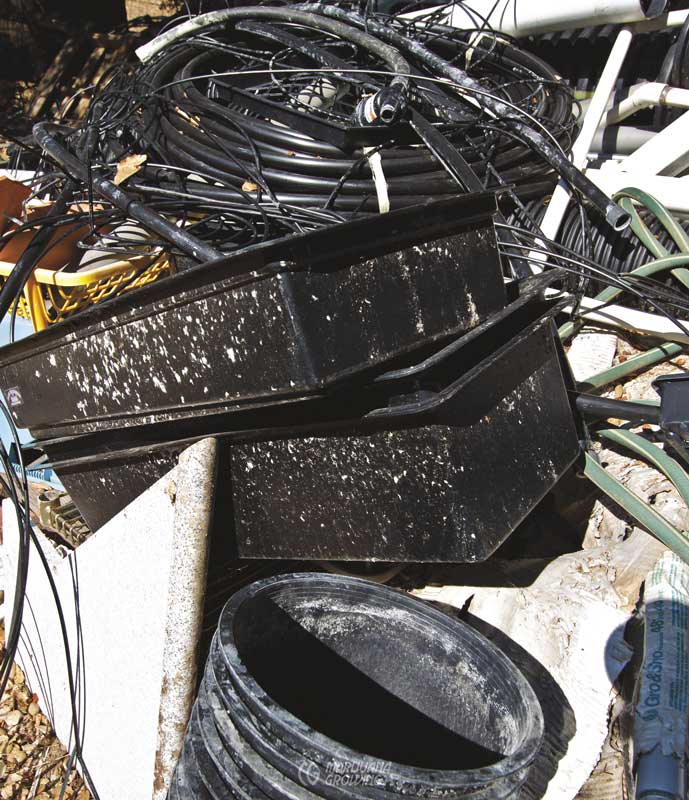
Keep garden trash out of plain sight to avoid drawing attention and to keep the garden area clean.
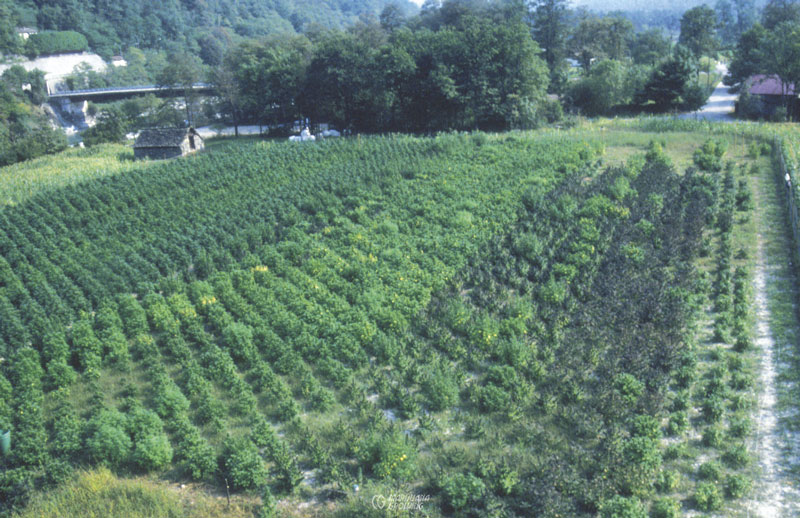
This legal cannabis garden was grown a few years ago in Ticino, Switzerland. All the paperwork was in order with local authorities to harvest a very large field of outstanding cannabis!
Internet Security
Internet traffic is so dense that it is virtually impossible to monitor or investigate all perceived crimes. Arresting medical cannabis gardeners who post photographs and text on the Internet is beyond the means of most law enforcement agencies, which are overwhelmed with budget cuts and controlling violent criminals, not to mention addressing property theft, policing traffic, and helping citizens in need.
What is true today can easily change tomorrow on the World Wide Web and iPads, iPhones, Androids, and other “smart” technology. Smart medical cannabis gardeners can easily have several levels of security. Personal privacy and preservation of your sanctuary are of utmost importance when communicating with other cannabis sites, including those related to activism, cultivation, nostalgia, and social networking.
Simple security measures for garden photos and videos uploaded to the Internet mandate that no tattoos, photographs, license plates, addresses, buildings, or landmarks be identifiable. Medical cannabis gardeners practice these simple measures to prevent theft and other possible problems.
Cell phones may record their location and time with an internal global positioning system (GPS), even when turned off. Newer cell phones can be turned off and will not record the location on GPS. Turn off the “location services” and put the phone on “airplane mode” with Wi-Fi disabled. Some gardeners remove the battery to ensure that their device is off. When the GPS and Wi-Fi are not disabled, locations of gardens photographed and videoed with cell phones can be pinpointed. Removing the battery from your cell phone is a simple way to avoid being tracked when traveling to secure locations.
As a precaution against automatic transmittal of data, turn off iCloud and other mobile tech services and devices when in the vicinity of the garden sanctuary.
Facebook and other traceable photos of your cannabis garden should not be posted if you are concerned about crop theft. Be careful if your employer frowns upon medical cannabis cultivation. Everybody in the world has access to your “private” Facebook information. Strangers can access it from any cell phone or computer.
You can find many websites about online security. Type “Internet anonymity” into a search engine to find simple, easy ways to conceal your Internet identity from unsavory types.
Keep your computer secure from criminals and government snoops. Check such sites as https://en.wikipedia.org/wiki/Pretty_Good_Privacy#OpenPGP, and google “proxy server” for more information about Internet security.
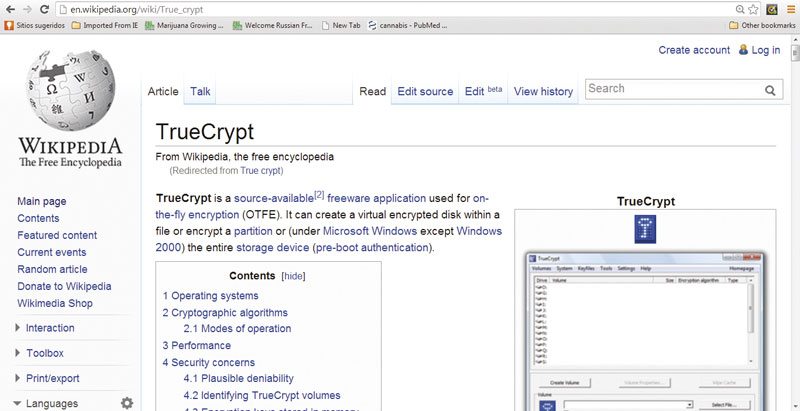
TrueCrypt is a well-known Internet encryption site. Security experts recommend carefully researching all security measures.
Outdoor Security
A safe gardening location is the primary concern for medical cannabis gardeners. Make sure to have all your paperwork in order. Medical cannabis gardens are private. Doctor’s patient records are private too. All records should be confidential. It is the business of the doctor and the medicinal cannabis gardener and patient; nobody else need be concerned. Check with local authorities and with www.norml.org for current status of laws.
If you should happen to come across another cannabis garden while walking in the forest or countryside, do not touch it; leave no sign you were there. Respecting other gardens is the honorable thing to do.
Gardens planted on public land risk detection by hikers, fishermen, other outdoor enthusiasts, and people surfing on Google Earth. Passersby are normally interested in their specific sports and recreation; they will not go out of their way to find your garden unless you lead them to it. Internet surfers are different. Anybody with a computer and an Internet connection can use Google Earth to spot large outdoor gardens in medical cannabis states. Greenhouses and ponds really stand out!
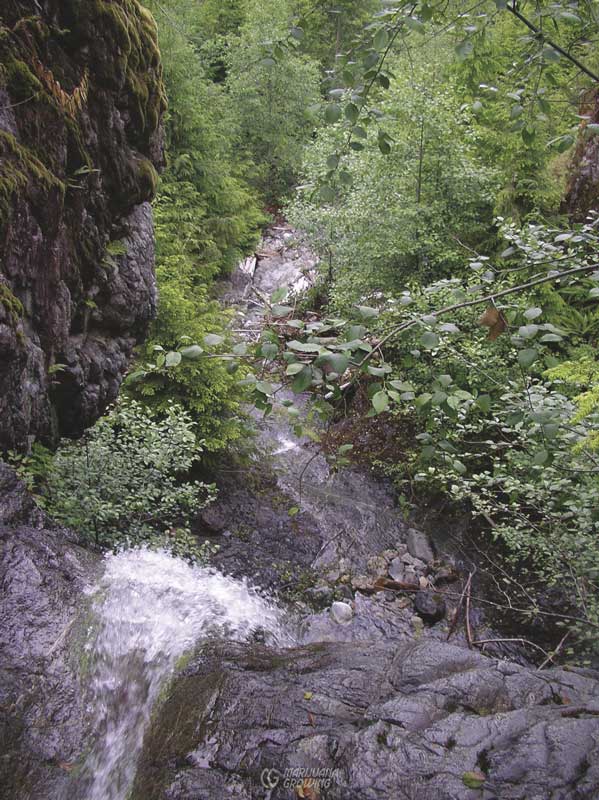
One way to help ensure that nobody finds your garden is to make the trail to the garden difficult to follow.
Remote Garden Security
In many parts of the world, gardeners are forced to cultivate remote gardens and must therefore be prepared with an array of skills to be able to plant and harvest a small garden in backcountry. Gardeners are likely to encounter curious hikers, fishermen, or hunters, any or all of whom might wonder why you are out there in remote country. Most often, these folks are just concerned citizens. A late-afternoon garden visit is a good time to “see wildlife,” since most backwoods tourists are on their way home late in the afternoon.
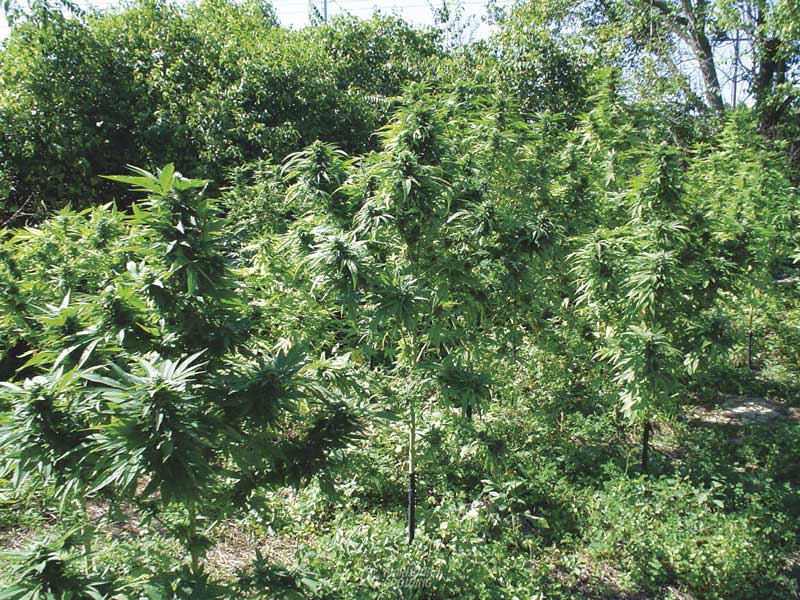
Ideally, a remote garden can be planted reasonably near the home so it can be maintained properly.
All medical patients and gardeners should carry a cell phone to communicate with a partner or call for help when in danger. Turn off the ringer. Paranoid gardeners know that some smartphones track their geographic location and route. Some gardeners go so far as to remove the battery before going to their gardens.
Here are a few of the tactics medical cannabis gardeners in remote areas are forced to employ to ensure that they harvest their crop:
- Park vehicles discreetly, away from the trailhead that leads to your medical garden.
- Bring growing supplies such as PVC pipe, pumps, water tanks, soil, bricks of coconut fiber, and compost to the garden site and stockpile them over time. Tote a few things to the garden each visit.
- Cover shoe soles with duct tape. The style, size, and sole pattern of shoes can be determined by tracks that could ultimately lead thieves or cops to the medical garden. Shoeprints could be used as evidence if the medical garden is discovered by law enforcement.
- Look for motion-activated, trail cameras perched in trees, especially in open areas!
- Install a trail camera or garden camera to see who and what is frequenting the remote garden.
- Disguise plants by bending, pruning, or splitting the stem down the middle. Bending branches is the least traumatic method and has more subtle effects on hormones, liquid flow, and physical shape. See “Pruning and Bending” in chapter 6, Vegetative Growth. There are also camouflage sleeves available to cover pots.
- Plant cannabis among other plants of similar size and foliage. Grow in a thicket of thorny bushes or other unpleasant foliage such as poison oak, poison ivy, or stinging nettles to discourage intruders. (Stinging nettles disguise cannabis fairly well, but brushing up against them is met with a burning sensation for about 20 minutes.) Look for bushes that are dense and high enough to shelter the medical garden from view. This deters large animals or people from wandering into the site. Protect yourself from these plants with a slick rain suit and gloves. Wash after each visit to remove irritating toxic oils and thorns. Some gardeners plant where there are a lot of mosquitos or wasps, and at least one gardener I know plants near a skunk’s den. The pungent spray keeps people and animals at bay.
- Some gardeners climb 30 feet or higher up into the trees to plant on stands in the canopy or use deer and elk stands as growing platforms. Set up a pulley system to lift large containers and potting soil up to the platform. Install an irrigation hose from the base of the tree up to the planting area and arrange around the pots so you can perform weekly watering with a battery powered pump rather than climbing the tree, and be sure to use climbing belt with harness and safety lines. Do not overextend yourself. I used to climb trees for a living, and my hard-and-fast rule when I was 25 years old was to spend no more than four hours climbing per day. When you get tired, accidents happen. If you hurt yourself, you will not be able to care for your plants! Avoid making a distinguishable path to the garden by taking a different route every visit. Walk on logs and rocks and in stream beds to avoid disturbing the natural habitat. Rapid growth of native plants will erase any obvious trail. Fertilizing the trail may cause wild plants to overdose on nutrients. In late summer and early fall, most native plants in dry climates will not re-grow.
- DO NOT use booby traps, bear traps, or firearms attached to tripwires to protect your crop.
- DO NOT have anything that could be construed as a clandestine protection device or firearm near garden areas. Such things are dangerous and could be implicated in legal proceedings.
- Always locate the garden in a different area every year. Do not use the same location twice. Always clean up the garden site so there is no trace of cannabis cultivation.
Finally, search for “electronic device detector” on Google for more information about detecting electronic devices. Cannabis gardeners in Northern California used to carry police scanner radios to listen to police conducting raids for the Campaign Against Marijuana Planting (CAMP). Informed gardeners could decipher the location of the next raid. Radio scramblers and decoders are also available.
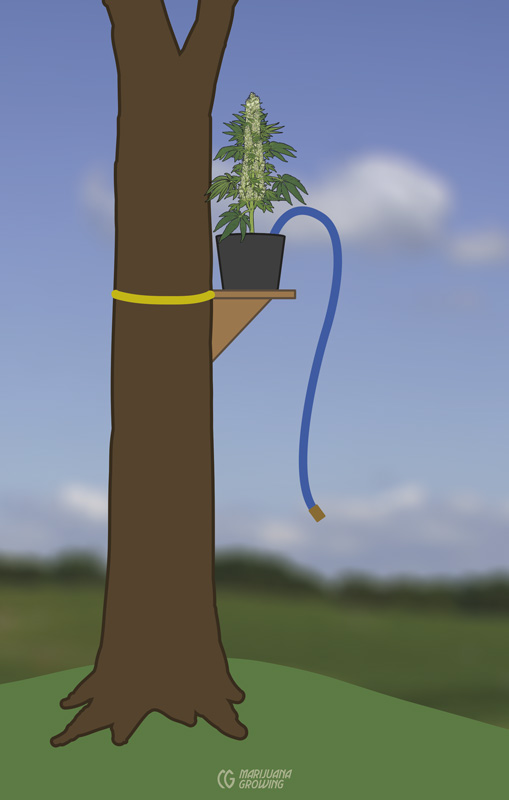
Growing cannabis up in trees is one way to avoid detection.
Law Enforcement
A COP is a “constable on patrol,” according to the old English acronym. In theory cops are a force in the community to “serve and protect or protect and enforce” our legal rights. Many law enforcement officers do not believe in unjust laws that they are contracted to enforce; others do. However, cops are subject to the same rhetoric that many of us have endured for years as victims of the War on Drugs, and they often make uninformed legal decisions based upon misinformation.
Avoid contact and confrontations with law enforcement whenever possible. If you should happen to come into contact and speak to a police officer, be polite, direct, and busy—going somewhere. The first place most people meet a police officer is in a traffic stop. Officers are aware of what is going on around them, and they know what burned cannabis smells like. Do not smoke cannabis in the car. It is illegal in many places.
Know your legal rights. Study local, province, state, and federal laws in your jurisdiction. Be better prepared than law enforcement is!
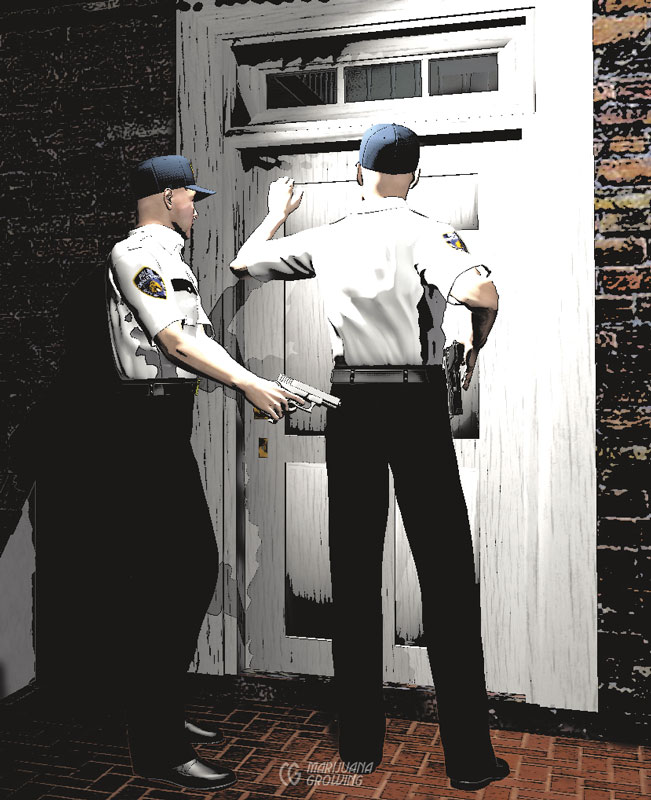

Since Barry Cooper, a retired drug cop from Texas, stopped busting citizens, he and his wife, Candi, have been endless campaigners for an end to the War on Drugs.

Nate Bradley is one of many ex-law enforcement officials from LEAP, Law Enforcement Against Prohibition.
We had no rights in Spain during the time of “El Caudillo,” Francisco Franco, the last dictator in Europe (1939–1975). Paramilitary Guardia Civil could enter your home (or anywhere else) with an administrative “search warrant.” Extreme repression, long prison sentences, and death orders dominated the system.
Today, with no dictator to fear, we enjoy more personal freedoms in Spain than in the majority of states in the USA!
Depending upon the country in which you live, law enforcement must first have a search warrant to use infrared or thermal imaging devices. But if they have a search warrant, such high-tech snooping is perfectly legal. If you want to take a look at what they see, rent heat-sensitive night-vision glasses from your local military supply store, or take a photo of the outside of your grow operation with infrared film. You can also add a filter to your digital camera and convert the photos with a few clicks of Photoshop to show heat signatures.
Law enforcement has sophisticated telephone bugging devices, sensitive directional microphones, infrared scopes, thermal imaging, and more. They can also subpoena telephone, Internet, and electrical company records. Intimidating police officers coerce electric company employees to break the law, violate personal rights, and give them the records of unsuspecting consumers. Tracking telephone numbers—including the location and route of a cell phone—is very easy. There has been more than one case where US law enforcement illegally acquired telephone records and illegally listened to garden store telephones. Unscrupulous law enforcement officials use telephone records to target gardeners.
Here is a real eyeful of how the Internet has spawned a slew of law enforcement seminars (www.indoorgrowtraining.com). Some of these seminars look to expand city, state, and national law enforcement budgets in the future; others are contemporary. Once you watch the video you will understand the importance of not keeping cash and scales at the garden house.
Barry Cooper was a drug cop in Texas; now he is a friend. But Barry will always be a Texan! After years of being a homegrown drug cop hero, Barry realized he was part of the problem in the War on Drugs, not part of the solution. If you want to know how a cop reacts and what is on his mind, check our Barry Cooper’s video and website at www.nevergetbusted.com. It is crammed with details of legal (normally called “clandestine” and “overt”) activities peace officers use every day to enforce laws.
Law Enforcement Against Prohibition (LEAP) is a wonderful group of current and former law enforcement and criminal justice officials who speak out about the failures of existing drug policies in the USA. Check out their website (http://leap.cc/) and learn how law enforcement is changing.

Check out the LEAP website http://www.leap.cc/.
National Organization for the Reform of Marijuana Laws (NORML)

The National Organization for the Reform of Marijuana Laws is one of the many cannabis legalization organizations around the world that provide legal information.
Always keep a lawyer’s card with a 24-hour contact telephone number with you!
Check out the site of the National Organization for Reform of Marijuana Laws (www.norml.org) and download your NORML Foundation Freedom Card.
THE NORML FOUNDATION FREEDOM CARD
The U.S. Constitution prohibits the government from interfering with your right to remain silent, to consult with an attorney, and to be free from unreasonable searches and seizures by law enforcement. However, it is up to you to assert these rights. This NORML Foundation Freedom Card will help you do so effectively.
If you are confronted by a police officer, remain calm. Be courteous and provide your identification. Politely refuse to answer any further questions. Ask to talk to an attorney. Do not consent to any search of your person, your property, your residence or your vehicle. Tell the officer you would like to give them this card, which is a statement of the constitutional rights you wish to invoke. Do not reach for this card until you have obtained the officer’s permission to do so.
If the officer fails to honor your rights, remain calm and polite, ask for the officer’s identifying information and ask him or her to note your objection in the report. Do not attempt to physically resist an unlawful arrest, search or seizure. If necessary, you may point out the violations to a judge at a later time.
Here is a brief excerpt from the LEAP website:
- Don’t leave contraband in plain view. Law enforcement can confiscate your medicine and arrest you. They have discretion.
- Never consent to a search or talk to an officer if you want to reserve your rights.
- Don’t answer questions without your attorney present.
Like me, most of the Law Enforcement Against Prohibition members, are older and have seen and felt their fair share of good and bad. They have been enforcers of the War on Drugs and understand that the war on the cannabis plant and the people who cultivate and consume it is contrary to Mother Nature.
Informants
In many countries, including states in the USA, a cannabis gardener is considered a criminal and can suffer endless legal turmoil including a long stint in prison. In many countries, conspiracy laws and “incitement and conspiracy to grow cannabis” laws—including the RICO statutes in the USA—were enacted to break up real mafias and political uprisings. Conspiracy, incitement, and racketeering laws are used every day to incarcerate medical cannabis gardeners. Conspiracy and incitement laws are wide-ranging and a catchall way to use hearsay evidence to convict medical cannabis gardeners. They are used all over the world to enforce restrictive cannabis laws. Until the proliferation of Internet communication, these laws have silenced many publications. See “About Jorge” in the back of the book for more information.
The USA Patriot Act 2001 also curtails many personal and human rights in the USA. Ed Rosenthal’s Marijuana Grower’s Handbook, 2011, has a very good section on the USA Patriot Act and how to avoid informants and cops. Ed speaks from experience! See www.edrosenthal.com for more information.
A lawyer friend told me that the USA is an “adversarial” law community. This is why some medical cannabis gardeners always deny growing—always, even if proven otherwise. Some medical cannabis gardeners transform into helpless victims once arrested. Other proud medical cannabis gardeners have their paperwork in order and do not allow law enforcement to waste their time and tax dollars. But when arrest an un-prescribed “friend” that has seen your garden is arrested, police in the USA and other countries can legally use deception and intimidation to trick your “friend” into betraying you and your medical garden. Investigations and interrogations can last for months in many countries.
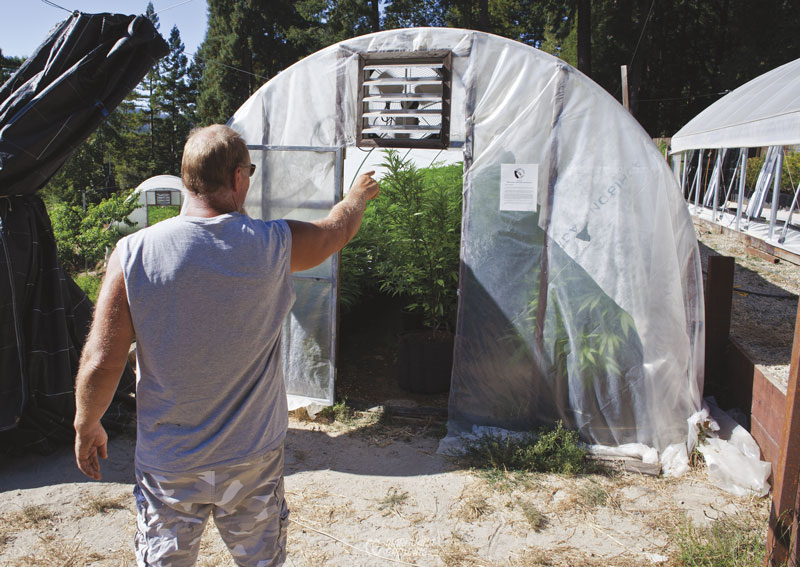
Police informants like the one above are often weak-minded “friends” or disgruntled neighbors that “get even” by squealing on your gardening activities.

Ed Rosenthal is an expert on the court system in California in relation to cannabis prohibition laws.
High-Tech Surveillance
Thermal Image Technology
Unfortunately we are obligated to include this page in the book. Thermal imaging technology is an issue among cannabis gardeners in some countries. Thermal image technology is an invasion of citizen household privacy and is illegal in every country with specific privacy laws. In the USA thermal images are illegal as a means to secure a search warrant, but in Canada, Holland, and other countries, authorities fly in matrix patterns over urban areas to look for alleged indoor cannabis gardens. Thermal imaging technology is the same technology that guides missiles, including smart bombs. Nonetheless, thermal imaging technology is seldom a problem for small gardeners who use less than 2000 watts of light and have a small greenhouse or a few cannabis plants.
Relatively inexpensive (less than $1,200 USD) thermal imaging devices are now affordable for smaller police forces. Thermal imaging devices have been used legally to measure the heat signature escaping from structures. This invasive “evidence” is used with other “evidence” to secure a search warrant. According to US police sources, the devices are legal only to find heat escaping from windows, vents, and so forth. Most often, narcotics agents use the cameras illegally to secure a search warrant.
Some gardeners avoid potential thermal imaging problems by turning grow lights on during the daytime to confuse thermal imaging devices. Daytime heat and light make accurate measurement of heat coming from vents and windows impossible; thermal imaging cameras are therefore of limited use during sunlit daytime hours. Shield and insulate walls and windows against heat loss from lamps. Store ballasts in separate rooms, and channel the heat away from the garden. Gardeners further safeguard their gardens by cooling garden room air before exhausting outdoors so it does not leave a heat trail. Air vented out underneath a structure is nice and cool before mixing with the outdoor environment.
Learn more about thermal imaging at http://en.wikipedia.org/wiki/Thermography.
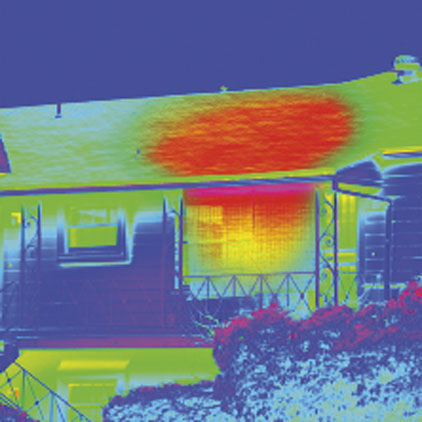
Thermal imaging technology has become less expensive and more accessible to law enforcement and citizens.
Mini Helicopters
A mini helicopter called the “Smell MJ Growing” or “Sniff-O-Copter,” in German, was developed in Switzerland and first used in the Netherlands in 2009. The remote-controlled drone helicopter is able to search and stay in the air for up to 8 hours. According to its manufacturer, its fragrance sensors are so accurate that the garden room location and level can be accurately pinpointed. It can fly over houses and sniff chimney and other vent exhaust.
To date, no law enforcement budgets have been able to pay for a mini helicopter to sniff around my home and others. We are pleased that law enforcement budgets do not include such frivolous items to entrap honest citizens.
In some US jurisdictions where firearms are legal, and where mini helicopters are being used to spy on residents, expert marksmen have been known to shoot the little copters out of the air.

Drone helicopters are relatively inexpensive and easy to outfit with a camera that sends video to a computer.
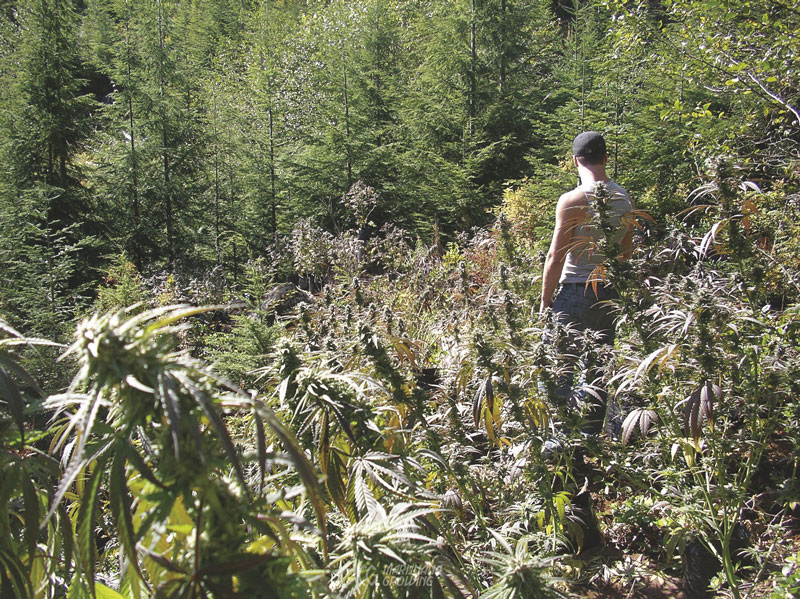
Caution! Thieves can find remote gardens!

